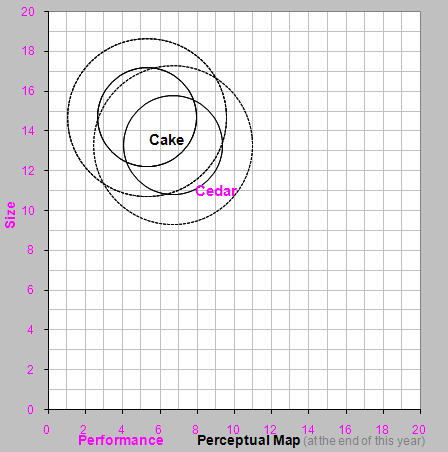13.3 Broad Cost Leader - Practice Round 1
Practice Round 1
Follow the decisions below. After the practice rounds are complete and the competition rounds begin, you are free to choose a different strategy; you are not obligated to continue as a Broad Cost Leader.
R & D Round 1
Cake - Reduce reliability (MTBF) to reduce material cost. Example: Reduce MTBF from 21000 to 18000. Do not reduce MTBF below 17000 hours, because that is the lower limit of acceptable reliability (MTBF) for High Tech customers.
New Product - Launch a new High Tech product, with a project length less than 2 years (no later than December of next year). Example: Name: Cedar (replace the first NA in the list), performance 9.0, size 11.0 and a reliability (MTBF) 20000.
Important: Under the rules of the simulation, the names of all new products must have the same first letter as the name of the company.
Important: With the exception of the new product, make certain that the projects complete during this year before December 31st. Under the rules, a new project can only begin on January 1st. If these projects do not complete before the end of this year, you cannot begin follow-up projects next year.

Perceptual Map from the Research & Development Spreadsheet: Product names in black indicate the product's current location, names in magenta indicate the product's revised position (with slight revisions, the names will overlap). Names of newly invented products appear in magenta.
Marketing Round 1
Cake - Make moderate price cuts and decrease promotion and sales budgets. Forecast unit sales near last year's level. Example: Price $33.50, promotion budget $800, sales budget $800. Forecast sales of 1300 units.
New Product - Marketing decisions will be made next year when the new product is ready to begin production.
Production Round 1
Production schedules will plan for eight weeks of inventory. That is, have enough inventory on hand to meet demand eight weeks beyond the sales forecast. This requires a 15% inventory cushion (8/52 = 0.15). For example, suppose Marketing forecasts demand at 1000, and you have 100 units in inventory. You want 1000 x 115% = 1150 available for sale. Since you have 100 on hand, you would schedule 1050 for production.
If you cannot meet demand, sales go to competitors. Therefore, you want to plan for the upside as well as the downside. Your proforma balance sheet will forecast about eight weeks of inventory. You hope that your actual sales will fall between your sales forecast and the number of units available for sale.
Schedule production for your existing product using this formula:
(Unit Sales Forecast X 1.15) - Inventory On Hand.
Cake - Increase automation level by 1.0 point.
New Product - Buy 300,000 units of capacity by entering 300 in the Buy Sell Capacity cell. Set an automation level of 3.0.
Important: There is a one year lag between purchase and use of new capacity and automation for both new and existing products.
Important: Make certain the Cake project completes during this year, before December 31st. Under the rules, a new project can only begin on January 1st. If a project does not complete before the end of this year, you cannot begin follow-up project next year.
Finance Round 1
Your fiscal policies should maintain adequate working capital reserves to avoid a liquidity crisis. Working capital can be thought of as the money that you need to operate day-to-day. In Foundation® working capital is current assets (cash + accounts receivable + inventory) - current liabilities (accounts payable + current debt). If you run out of cash because your sales are unexpectedly weak, an Emergency Loan will be issued.
Here are some guidelines to help you avoid an Emergency Loan . Your proforma balance sheet predicts your financial condition at the end of this year. Make conservative sales forecasts. Do not rely on the computer prediction. Override it with a forecast of your own. If you are conservative, it is unlikely that your worst expectations will be exceeded. Next, build additional inventory beyond your conservative expectations. This forces your proforma balance sheet to predict a future where your sales forecast comes true and you are left with inventory. (If you sell the inventory, that's wonderful.) On the Finance spreadsheet, issue stock, bonds or current debt until the December 31 Cash Position for the upcoming year equals at least five percent of your assets, as displayed on the proforma balance sheet. This creates an additional reserve for those times when your worst expectations are exceeded and disaster strikes.
As you gain experience with managing your working capital, you will observe that the guidelines above make you somewhat "liquid," and you may wish to tighten your policy by reducing cash and inventory projections. That is fine. The better your marketing forecasts, the less working capital you will require.
Match your plant investment with a long-term bond. If you do not have sufficient new bond debt capacity, issue stock to cover the shortfall.
Do not pay a dividend.
Save decisions (select "directly to the website").
